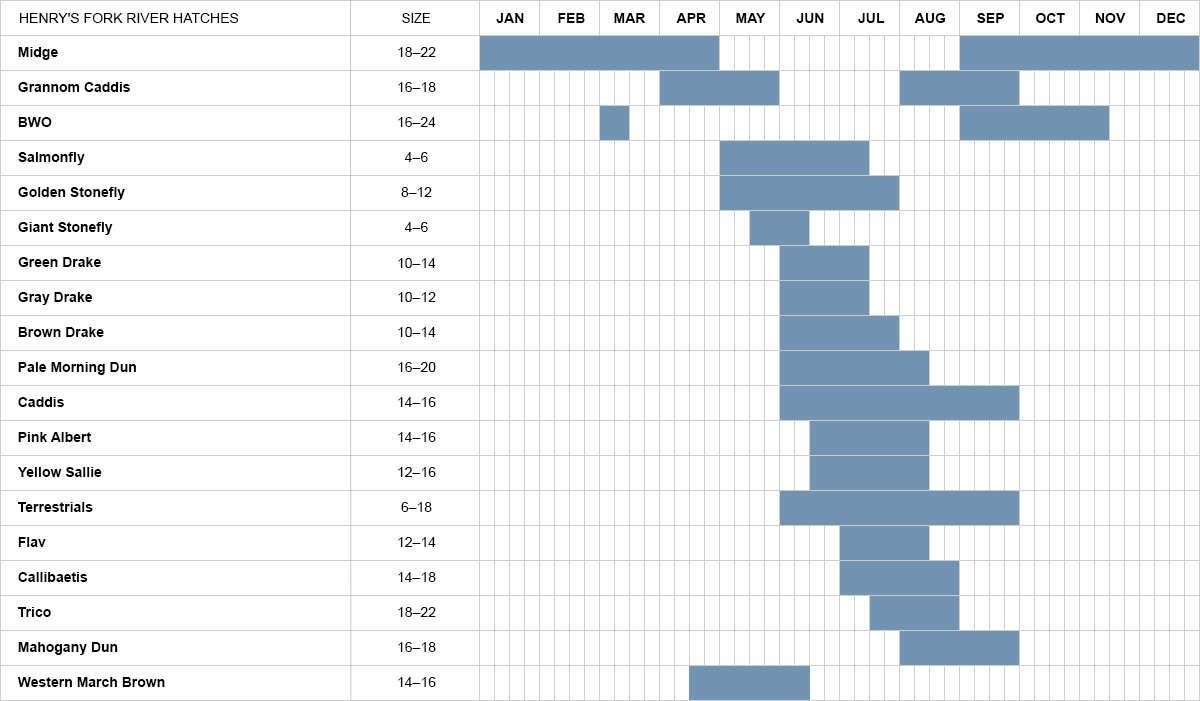Henry’s Fork hatch chart of the major mayfly, caddisfly and stonefly hatches occuring on Henry’s Fork River in eastern Idaho. Fly hatch sizes and emergence dates may vary due to changes to annual water flows and weather conditions.

Henry’s Fork flies go through three stages: Nymph (Larvae), Pupae/Emergence, and Adult. Prior to the hatch date listed in the following chart, flies typically exist as nymphs subsurface. This stage provides a great opportunity for anglers to target trout subsurface using nymph patterns and wet flies.
| Fly Hatch | Size | Date |
|---|---|---|
| Midge | 18 - 22 | Jan 1 - Apr 30; Sep 1 - Dec 31 |
| Grannom Caddis | 16 - 18 | Apr 1 - May 31; Aug 1 - Sep 30 |
| BWO | 16 - 24 | Mar 1 - May 15; Sep 1 - Nov 15 |
| Salmonfly | 4 - 6 | May 1 - July 15 |
| Golden Stonefly | 8 - 12 | May 1 - July 31 |
| Giant Stonefly | 4 - 6 | May 15 - June 15 |
| Green Drake | 10 - 14 | June 1 - July 15 |
| Gray Drake | 10 - 12 | June 1 - July 15 |
| Brown Drake | 10 - 14 | June 1 - July 31 |
| Pale Morning Dun | 16 - 20 | June 1 - Aug 15 |
| Caddis | 14 - 16 | June 1 - Sep 30 |
| Pink Albert | 14 - 16 | June 15 - Aug 15 |
| Yellow Sallie | 12 - 16 | June 15 - Aug 15 |
| Terrestrials | 6 - 18 | July 1 - Sep 30 |
| Flav | 12 - 14 | July 1 - Aug 15 |
| Callibaetis | 14 - 18 | July 1 - Aug 31 |
| Trico | 18 - 22 | July 15 - Aug 31 |
| Mahogany Dun | 16 - 18 | Aug 1 - Sep 30 |
| Western March Brown | 14 - 16 | Apr 15 - June 15 |
Major Hatches on the Henry’s Fork of the Snake River
There are several major fly hatches that occur on the Henry’s Fork—a few more important than others.
One of the first hatches of the year, and most important for anglers to prepare for, is the Blue-winged Olive (BWO). BWO hatches occur for a brief time in early spring and then return force in September and October. You may also find sporadic BWO hatches throughout the summer months. Having a good selection of Blue-winged Olive patterns is advisable.
March Brown is another hatch to pay attention to. You’ll find March Browns hatching mostly in faster current areas between mid May and mid June. At the same time Green Drake hatches are also appearing on the lower sections of Henry’s Fork. Little Green Drakes—called Flavs—begin hatching just after Green Drakes and are around through the middle of July.
Gray Drake and Brown Drake hatches enter the scene in June and typiclly continue through mid July. Gray and Brown Drakes are a larger mayfly. Targeting trout using some good Drake imitation patterns can net you some large trout.
Mid June, Pale Morning Dun (PMD) hatches enter the fray and are abundant through mid August. This is probably one of the best mayfly hatches on the Henry’s Fork of the Snake River. You don’t want to miss this hatch, and you don’t want show up unprepared. Having a few PMD imitation nymphs and dry flies is a must.
From July through September, hatches you want to look for are Tricos, Speckle-wing Quills (aka “Callibaetis”) and most important Spotted Sedge caddisfly. Trico hatches tend to be sparse and sporadic. Callibeatis hatches are a bit more consistent. Spotted Sedges hatch from June through September and are plentiful.
In addition to Spotted Sedge, there are numerous species of lesser known caddisfly hatching on Henry’s Fork through the summer and into early fall, such as Long-horned Sedges, Little Speckled Peters, and Black Dancers.
And… we don’t want to forget, midges. Midge hatches occur year round and are most important during the colder weather and when there aren’t any other hatches on the water. Having a decent supply of midge patterns—nymph and adult—is recommended.
During the summer months, if the trout just aren’t biting, fishing terrestrial patterns, scuds, sculpin, and minnows will often start generating strikes.



